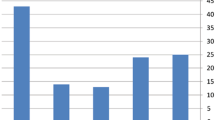Abstract
Background
The problem of unexploded ordnance (UXO) is global and is usually associated with active or former war zones. Civilian injuries due to UXO in military training areas are not common.
Methods
This is a retrospective case series study based on prospectively collected data on patients who sustained injuries from UXO explosions and were admitted to the Soroka University Trauma Center during a five-year period.
Results
Twelve patients were included in this series. All patients were Bedouin and the distribution of injuries was concentrated around the head and upper and lower extremities, with sparing of the torso.
Conclusion
Awareness and implementation of preventive measures are expected to reduce the incidence of this type of injury.

Similar content being viewed by others
References
Stenström M, Westrin P, Ritchey T. Living with UXO: using morphological analysis for decision support in phasing out military firing ranges (adapted from a report to the Swedish Armed Forces UXO program). 2004. http://www.swemorph.com/pdf/oxa1.pdf. Accessed 11 Nov 2012.
Coupland RM, Korver A. Injuries from antipersonnel mines: the experience of the International Committee of the Red Cross. BMJ. 1991;303(6816):1509–12.
Morikawa M, Taylor S, Persons M. Deaths and injuries due to unexploded ordnance (UXO) in northern Lao PDR (Laos). Injury. 1998;29(4):301–4.
Bendinelli C. Effects of land mines and unexploded ordnance on the pediatric population and comparison with adults in rural Cambodia. World J Surg. 2009;33(5):1070–4.
Bilukha OO, Brennan M, Anderson M. Injuries and deaths from landmines and unexploded ordnance in Afghanistan, 2002–2006. JAMA. 2007;298(5):516–8.
Can M, Yildirimcan H, Ozkalipci O, Melek M, Edirne Y, Bicer U, et al. Landmine associated injuries in children in Turkey. J Forensic Leg Med. 2009;16(8):464–8.
Watts HG. The consequences for children of explosive remnants of war: land mines, unexploded ordnance, improvised explosive devices, and cluster bombs. J Pediatr Rehabil Med. 2009;2(3):217–27.
Etter D, Delaney WP. Report of the Defense Science Board Task Force on Unexploded Ordnance. Washington, DC: Office of the Under Secretary of Defense For Acquisition, Technology, and Logistics, 2003;20301–3140. http://www.cpeo.org/pubs/UXO_Final_12_8.pdf. Accessed 11 Nov 2012.
Central Bureau of Statistics, Israel Government. Abstract for 2006. 2006. http://www.cbs.gov.il/reader/shnaton/templ_shnaton.html?num_tab=st02_07x&CYear=2006. Accessed 11 Nov 2012.
UNICEF, UN. International guidelines for landmine and unexploded ordnance awareness education. 1999. United Nations, New York. http://www.mineaction.org/downloads/mineawar.pdf. Accessed 11 Nov 2012.
Conflict of interest
None of the authors has a financial relationship with or interest in any commercial entity that may have a direct interest in the subject matter of this article.
Author information
Authors and Affiliations
Corresponding author
Rights and permissions
About this article
Cite this article
Shaked, G., Beck, G., Sebbag, G. et al. Civilian injuries due to unexploded ordnance in military training areas in southern Israel. Eur J Trauma Emerg Surg 39, 113–115 (2013). https://doi.org/10.1007/s00068-012-0239-1
Received:
Accepted:
Published:
Issue Date:
DOI: https://doi.org/10.1007/s00068-012-0239-1




